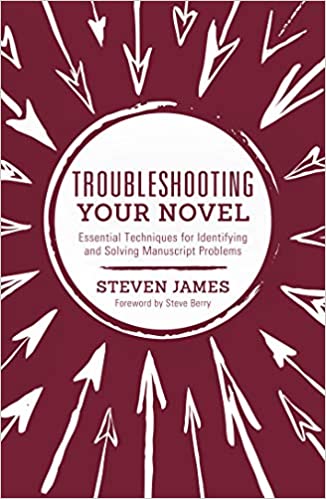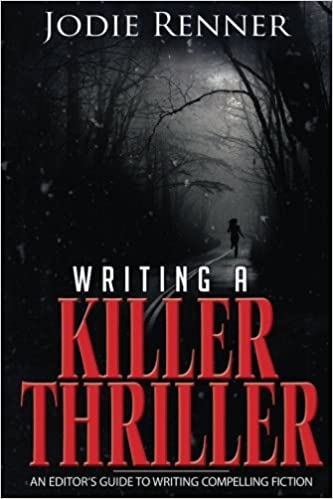My fellow Rogues are all bestselling thriller writers, so I’m sure they are familiar with these “Tips” for creating a great thriller. However, I figured I could always use a refresher course, or a reminder of the basics, so I recently watched a presentation on how to craft a great thriller given by author Dr. Amy Rogers, who has written a number of bestselling books and was a judge at our International Thriller Awards contest.

Many of her suggestions are described in great detail in the terrific book, Troubleshooting Your Novel by Steven James, Winner of the Storytelling World Award. Here’s a summary of the basic points:
- POV – Point of View:
- Writing in the third person is most common for thrillers (he, she, they).
- Stay in one character’s POV in each scene or chapter. One author who switches POVs in the same scene is Nora Roberts. But since she has sold some 40 million books, she can get away with it.
- Minimize the number of POV characters (otherwise you confuse the reader)
- THE OPENING:
- Write an opening that involves an external event (not a scene in someone’s head or waking up or in a bad dream). Something should happen or appear right away, a promise of things to come. Editors and movie producers often advise: “OOA” Which means “Open on Action.”
- CHARACTERS:
- Initially show them buffeted by outside forces
- Put them in a tough situation that forces tough decisions
- Show the character is good at something, has a sense of humor
- Have the character treat others well
- Perhaps your character suffered some misfortune in the past
- Finally show how your main character takes charge of the outcome
- DIALOGUE:
- Minimize “tags” – don’t use much of anything besides, “she said,” “he said” instead of “she answered in an exaggerated tone of voice.”
- Endeavor for equal parts of dialogue, narrative, and action
- Try to avoid what the experts call BOGSAT – “Bunch of guys sitting around talking.” Lots of characters in one scene can confuse the reader.
- Dialogue is stronger in places when it has a subtext – where the true meaning is left unsaid.
- TENSION:
- It’s born when conflict meets desire
- Try to have some tension in every chapter
- It is tense when something is at stake. Think about an “or else.”
- How the protagonist reacts to tension reveals character and advances the story
- CLIMAX:
- There should appear to be no way out
- The character’s choices should determine how the book ends
- Try not to have someone else come to the rescue
- If Plan A fails, have Protagonist go to Plan B, then Plan C
- Throughout the windup, use shorter sentences
- Focus on what the character is feeling when possible
- The climax needs to be long enough, so reader doesn’t feel cheated

Another excellent “how to” book for aspiring AND seasoned authors is Writing the Killer Thriller by Jodie Renner. This respected editor’s book offers “Essential strategies for supercharging your stories.” New York Times bestselling author, D.P. Lyle, observes, “Writing is hard, editing is harder, and self-editing almost impossible. This book demystifies each of these steps on the road to a published manuscript.”
As I said at the outset, I’m sure all of our Rogues have heard and implemented these “Tips” but, perhaps, they’ll be good reminders for other writers in the thriller genre.
Do you have any writing tips you’d like to share? Please let us know and thanks for visiting us here on Rogue Women Writers.
















































I love Steven James! But didn’t know that volume, so thanks for the tip, Karna. I enjoy Jodie on writing too.
Your stories, Jenny, are so compelling – it’s obvious you have employed many of the experts’ tips along the way!
I took notes.
This is a terrific blog that both writers and readers will get a lot out of. I particularly liked “There should appear to be no way out” at the ending. I call it the “all is lost moment.” That sure does rivet readers.
One of my favorite tips is to find a story that fascinates you, the writer. If it doesn’t fascinate you, it’s hard to fascinate readers.
Thanks, Karna!
You are so right, Gayle, about creating a story that fascinates you. They often say, “Write what you know” — but science fiction writers and those who research and write about historical events don’t follow that – they follow their interests – right? Thanks for your comment.
This is a great list, and we CAN always use a refresher lesson. Especially OOA, Open on Action. That used to be easy for me when my character was a working police forensic specialist, I just started every book with her standing over a dead body at a crime scene. Now that I’m trying to break out of that formula a little bit, I have to get more creative.
I’ve always enjoyed how your first chapters begin, Lisa, — but now I’ll look forward to your next thriller and see how you open the story!!
It’s always good to refresh the basics…and so many times it trips a trigger that helps with our WIP!
Lots of good reminders. And sometimes it’s fun to see how many of these we do without even thinking about them. Great blog post, Karna!